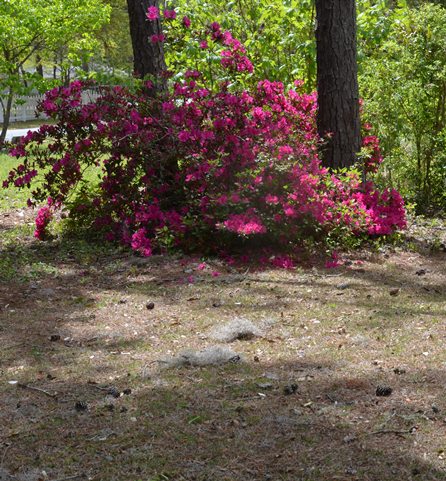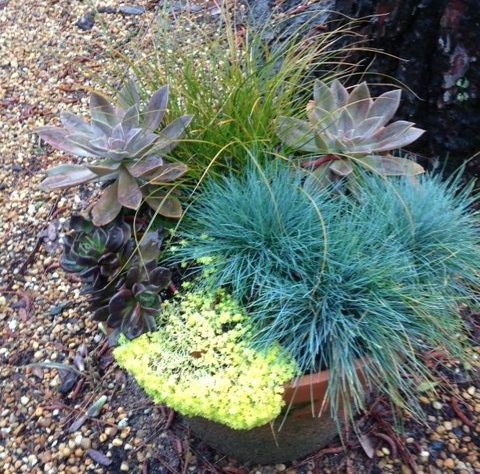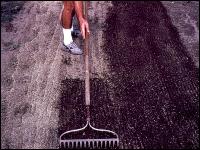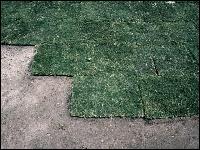by Les Harrison | Apr 8, 2014

While the azaleas may be blooming, most north Florida Lawns still need some work to be ready for the growing season.
Spring is officially here, so this means it is time to get the lawn in shape for another growing season in north Florida. The first step is to develop an action plan which sets the path to achieving turf success.
A good starting point is mowing the lawn to get any leaves removed and trim any weeds which have emerged. Empty the bagged clipping in a compost pile for later use.
Shaded areas under trees must be treated differently since grass will not grow in those areas. Just leave the natural tree leaf mulch there and add additional mulch as needed.
If there are marginally shaded areas where turf is preferred, spring is a good time to plant some grass plugs. All southern turf grasses prefer full sun, but a few St. Augustine cultivars such as ‘Seville’, ‘Delmar’, and ‘Captiva’ will tolerate some shade.
Trying some plugs of ‘Seville’ St. Augustine is a low-cost way of determining if there is enough sunlight to grow grass. The plugs are available at local garden centers.
If the plugs don’t take hold and spread, then there is not enough sunlight. Use groundcovers, mulches, or other plantings in these shaded areas.
Before mowing, use a ruler to set the cutting level. Try to never remove more than one-third the length of the grass blade at any one mowing.
Sharpen the mower blades after every four to eight hours of mowing so a ragged cut is avoided. Maintain St. Augustine grass at about three inches tall and centipede at about one and one-half inches.
Most of the weeds currently in panhandle Florida lawns are winter annuals. They are flowering and will soon go to seed, then die as the weather gets hotter.
It is difficult to kill these winter annuals at this mature stage, so applying herbicide now is pointless. The best option is to keep the weeds mown so they do not produce as many seed and reemerge next year. Also, apply a pre-emergent herbicide in October 2014 to minimize 2015’s spring weeds.
Now is the time to put out a pre-emergent herbicide for some of the summer weeds, particularly chamberbitter.
Unless a soil test indicates a need for phosphorus, the best fertilizers to use on lawns will be missing this nutrient. The commonly available 15-0-15 fertilizers should also have half of the nitrogen (7.5%) in a slow-release form.
Many local retailers have these 15-0-15 fertilizers with and without herbicide. Generally speaking apply the 15-0-15 fertilizer without herbicide. Below is a table of recommended fertilizer application rates based on typical lawn square footage.
Table 2. Recommended application rates for turfgrass fertilizers to Florida lawns: 15–30 percent slow-release nitrogen. From Publication #ENH979
| Use this table to match the size of your lawn to the percentage of nitrogen (N) in your fertilizer to find the amount of fertilizer you need to apply. If you have a bahiagrass lawn, apply this amount of fertilizer about four times a year no matter where you live in the state. For centipedegrass, apply about twice a year in north Florida . For St. Augustinegrass or zoysiagrass, apply about four to six times a year in north Florida. UF/IFAS recommends soil testing for phosphorus content before any P fertilizer is applied. |
| |
6% N |
10% N |
12% N |
15% N |
16% N |
23% N |
27% N |
| 1,000 ft2 |
8.25 lbs |
5 lbs |
4.25 lbs |
3.25 lbs |
3 lbs |
2.25 lbs |
2 lbs |
| 1,100 ft2 |
9.25 lbs |
5.5 lbs |
4.75 lbs |
3.5 lbs |
3.5 lbs |
2.5 lbs |
2 lbs |
| 1,200 ft2 |
10 lbs |
6 lbs |
5.25 lbs |
4 lbs |
3.75 lbs |
2.5 lbs |
2.25 lbs |
| 1,300 ft2 |
11 lbs |
6.5 lbs |
5.75 lbs |
4.25 lbs |
4 lbs |
2.75 lbs |
2.5 lbs |
| 1,400 ft2 |
11.75 lbs |
7 lbs |
6.25 lbs |
4.5 lbs |
4.5 lbs |
3 lbs |
2.5 lbs |
| 1,500 ft2 |
12.5 lbs |
7.5 lbs |
6.75 lbs |
5 lbs |
4.75 lbs |
3.25 lbs |
2.75 lbs |
| 2,000 ft2 |
16.75 lbs |
10 lbs |
8.5 lbs |
6.5 lbs |
6 lbs |
4.5 lbs |
4 lbs |
| 2,500 ft2 |
20.75 lbs |
12.5 lbs |
10.5 lbs |
8.25 lbs |
7.75 lbs |
5.5 lbs |
4.75 lbs |
| 3,000 ft2 |
25 lbs |
15 lbs |
12.75 lbs |
9.75 lbs |
9 lbs |
6.5 lbs |
6 lbs |
| 3,500 ft2 |
29 lbs |
17.5 lbs |
15 lbs |
11.5 lbs |
10.75 lbs |
7.75 lbs |
6.75 lbs |
| 4,000 ft2 |
33 lbs |
20 lbs |
17 lbs |
13 lbs |
12 lbs |
9 lbs |
8 lbs |
| 4,500 ft2 |
37 lbs |
22.5 lbs |
19 lbs |
14.75 lbs |
13.75 lbs |
10 lbs |
8.75 lbs |
| 5,000 ft2 |
41 lbs |
25 lbs |
21.25 lbs |
16.5 lbs |
15.5 lbs |
11 lbs |
9.5 lbs |
| *These recommendations assume use of a properly calibrated spreader. See www.yourfloridalawn.ifas.ufl.edu for instructions on calibrating your spreader. |
If the soil is too compacted, too wet, too dry, or has nematodes, certain weeds may grow better in those conditions than does your lawn grass. Take the time to identify why the grass is not growing well.
Rain has provided enough water so far this spring, but this could change at any moment. However, do not water unless it is needed.
Only water when about thirty percent of the lawn wilts, turning dull grayish color as the leaf blades roll inward. At that time water deeply, applying about one-half inch of water as measured in cans placed in the sprinkler pattern.
To learn more about proper turf care in north Florida contact your local UF/IFAS County Extension Office.
by Blake Thaxton | Apr 8, 2014

Currently, there is an heirloom tomato variety trial being conducted in a high tunnel  structure at the UF/IFAS West Florida Research and Education Center. Seven heirloom tomato varieties are being evaluated, along with one hybrid variety, for early season high tunnel production in the western panhandle of Florida. Now is a chance for vegetable producers and tomato garden enthusiasts to see the trial and get the most up to date production advice from UF/IFAS specialists and extension agents. Join us for the workshop, Tomatoes at Twilight!
structure at the UF/IFAS West Florida Research and Education Center. Seven heirloom tomato varieties are being evaluated, along with one hybrid variety, for early season high tunnel production in the western panhandle of Florida. Now is a chance for vegetable producers and tomato garden enthusiasts to see the trial and get the most up to date production advice from UF/IFAS specialists and extension agents. Join us for the workshop, Tomatoes at Twilight!
Topics to be discussed:
• General Tomato Production
• High Tunnel Tomato production
• Heirloom Tomatoes
• Water & Nutrient Management
• Disease Control

by Eddie Powell | Apr 1, 2014

Soil Sampling may save you time and money!
As spring approaches, many Florida homeowners are gearing up to grow their own vegetables. The most frequently asked question this time of year is, “why do I need to fertilize my soil?” The answer is simple – – not all nutrients are present in the right amounts to support good plant health.
North Florida is a prime example of an area lacking certain nutrients, since the soils in this area are generally infertile and acidic. Especially with all the rain from this past year! Therefore, soils must be tested and appropriate amounts of lime and fertilizer must be applied to the soil for adequate plant growth. If this is not done then the crops will suffer from inadequate plant growth and yield will suffer.
Most vegetable crops grow and perform best at a pH range, 6.0-7.0. A soil sample must be taken to determine soil pH. Feel free to bring one of those samples by your local University of Florida IFAS Extension office for your soils pH results. If the pH extends far below or above this range, then crop productivity will be significantly reduced. This happens because the crop cannot utilize the fertilizer properly. In other words, this causes the plant to use too much of some nutrients (like manganese, zinc, and iron) that are required in very small amounts and too little of some nutrients (like nitrogen, phosphorus, and potassium) that are required in larger amounts. The plant system becomes upset so to speak and does not function well and some plants may even die.
To avoid having your crop suffer because of a lack of fertilizer, contact your local University of Florida IFAS Extension Agent and ask he/she to help you select the best kind of fertilizer for your crop. After you have selected the correct fertilizer, make sure to ask your agent to assist you with the following:
- Be aware of the correct amount to be applied to the area where you plan to grow your vegetable crops
- Understand how to apply the fertilizer to the soil so that your plants will use it properly for an excellent crop yield.
Points to remember:
- For vegetables, keep your soil pH range between 6.0 -7.0 so that your crop can uptake the fertilizer properly
- Make sure to apply the correct amounts of fertilizer to the soil so that your plants will not suffer but produce high quality produce.

by Julie McConnell | Apr 1, 2014

Container garden. Image: Julie McConnell, UF/IFAS
Living in a condo, apartment, or home with small yard does not mean you can’t garden at home. Whether you are interested in edible plants or ornamentals you can create a fit that is right for your space by using containers.
The first step in container gardening is the same as for traditional landscaping. First, asses your site to determine the cultural situation. Is it sunny or shady? Is water available from rainfall or from a nearby spigot? Will salt or wind be a factor? Are there height and width limitations? All of these need to be taken into consideration when you are planning to plant. These are elements that we have very little control over, so it is best to choose the right plants for the place you have.
Choose a container that will allow for adequate root growth and good drainage. If growing annuals, perennials, or small vegetables, a pot that is 12-18” deep should be sufficient. For shallow rooted or plants that like dry conditions you can go smaller. If plants grow tall make sure that the weight of the soil and pot is enough to keep it upright in gusty winds. It is not necessary to buy a container, you can reuse something as long as the water will drain and it is sturdy. Large containers may not need to be filled completely, but can be filled with a lightweight filler such as upside down nursery pots, water or soda bottles with lids, or packing peanuts. Choosing a light weight filler material makes the container easier to turn or relocate if needed and reduces the cost of potting soil.
Once you have determined site conditions, select the type of plants you would like to grow. When choosing edibles, the amount of sunlight available may be a limiting factor. Although some herbs and vegetables may benefit from a little bit of shade, they still need a bright location in order to produce well. If your site is very shady, consider shade loving ornamentals such as fern, hosta, and impatiens.
Understand the sunlight, water, and fertilizer needs of each plant. Group plants together that have similar requirements because they will receive the same care. Most herbs like a hot, dry situation and very little to no fertilizer. Grouping one of these herbs with a tomato plant that needs consistent watering and regular fertilizer will create a situation where one plant will perform poorly.
Container gardens require more care than plants in the ground because they dry out faster and may get no water from rainfall, if placed in a covered area. Consider using micro irrigation designed for containers or choose plants with low water needs such as the grasses and succulents.
To read more about container gardening read Container Gardening for Outdoor Spaces ENH1095.
The Foundation of the Gator Nation
An Equal Opportunity Institution

by Larry Williams | Apr 1, 2014

Sodding Lawn Photo Credit: UF/IFAS

Hand Raking Lawn Area Photo Credit: UF/IFAS
Cutting corners during lawn renovation usually results in poor turf establishment and long-term lawn maintenance problems.
Occasionally it is necessary to renovate a lawn or replant sections of a lawn. When replanting a lawn, it is best to not cut corners – you’ll usually pay for it in the long run. One of the most important factors is to prepare a good planting bed when renovating a lawn.
It doesn’t matter if you intend to re-sod, re-sprig or reseed; you need a level, loose and well-drained planting site for your lawn. A level lawn is much easier to mow. The loose soil allows for quicker root and runner establishment. Also, a well-drained site allows excess water to drain, preventing some disease problems.
One option is to spray the existing weeds and grass with a glyphosate herbicide such as Roundup. Allow the proper number of days for the weeds and grass to turn yellow (usually seven to 10 days).
Next, thoroughly till the area to a depth of 6 to 8 inches to loosen the soil.
Finally, level and smooth the planting bed, raking and then dragging (if needed) the bed. This can be done with a hand-rake and a hand-pulled drag such as a piece of chain-link fence on smaller areas. A tractor with rake and a grading box can be used on larger areas. A second option is to rent a sod cutter or remove the existing grass with a shovel before tilling and grading the site.
But whatever you do, don’t just lay new sod or broadcast grass seeds over a compacted, uneven, old lawn. There are just too many possibilities of having long-term and costly lawn problems as a result.
For additional information on establishing a Florida lawn, contact your local University of Florida Extension Office or visit http://hort.ufl.edu/yourfloridalawn.











